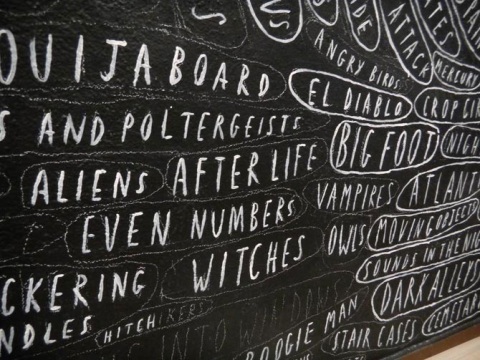
Brian Rea, "Visions and Fears Mural" (detail). Mural installation at the Joan Miro Foundation, Barcelona, Spain.
Every Wednesday night, my grammar teacher takes chalk to blackboard to underline subjects and circle direct objects. White dust falling to the floor, she puts brackets around prepositional phrases and writes sentence codes on the side of the board. As students look out the window at summer’s hazy dusk and green grass, she remains resolute, unyielding in her mission to transform language into a series of arcs, underlines, and circles. Unconcerned with each word’s meaning and cadence, its syllables or suffix, she cares only for the larger system, the rigid categories into which each word fits.
I hate her, not simply because she gives pop quizzes and accepts late homework only through the U.S. Postal Service. I hate her because she tries to rob language of its mystery. Nuance, individuality, and meaning are lost when complex entities are squished into finite slots. A line of poetry and a piece of technical writing may be diagrammed identically, but they are hardly the same. While poet Mary Oliver writes, “I am shaking; I am flashing like tinsel,” and my computer’s owner’s manual explains, “The battery will be hot; it may explode in water,” her logic simplifies both to “S-LV-PA; S-AV-P-OP” (that’s “subject-linking verb-predicate adjective; subject-active verb-preposition-object of the preposition” for those not enrolled).
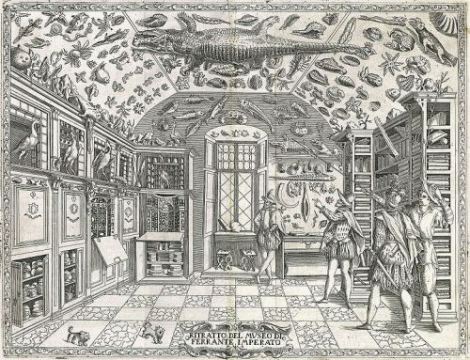
An early Wunderkammer. Courtesy copperandwood.wordpress.com.
This tension between the technical and the poetic is hardly limited to my Wednesday night grammar class, or even to language. It reflects a philosophical divide that dates back to the Enlightenment, the period during the seventeenth and eighteenth centuries when reason replaced mysticism and theology as the dominant mode of thought. Scientific rigor and rational thinking was prized above all else; the accumulation of knowledge became an end in itself.
The era’s embrace of empiricism pervaded its modes of visual communication, as well. In “Transitional Object,” Celeste Olalquiaga explores the Enlightenment’s evolving methods of display to illustrate the philosophical sea change then underway. She opposes the Wunderkammern of the pre-Enlightenment era with their successor, the curiosity cabinet. Although they are often conflated, Olalquiaga distinguishes between these two exhibition spaces. Wunderkammern, or wonder chambers, displayed bones and artworks, asteroid chunks and bird feathers together. In these sites of superstition and mystery, “products of ‘divine’ and human craft … lived side-by-side as objects of amazement,” she writes in a 2005 issue of Cabinet.
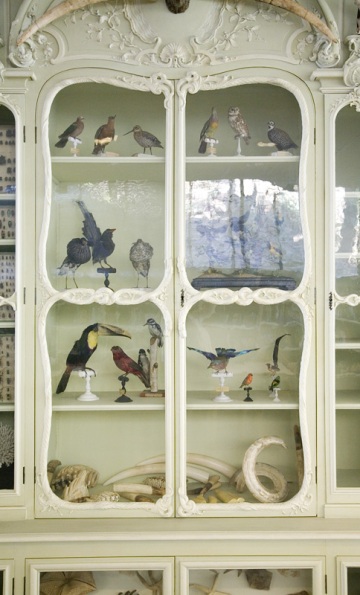
Cabinet of Curiosities of Bonnier de la Mosson Housed at the Bibliotèque centrale du Muséum national d'Histoire naturelle, Paris. Courtesy copperandwood.wordpress.com.
In contrast, the curiosity cabinets of the seventeenth and eighteenth centuries sought to impose order on these previously disparate collections. Considered precursors to the modern museum, curiosity cabinets “mark the onset of a desire to grasp and control the mystery which made nature such an enthralling realm.” They separated natural objects from man-made ones and introduced classification and specification into what had been zones of awe. Displays were put behind glass and moved into drawers, distancing the viewer.
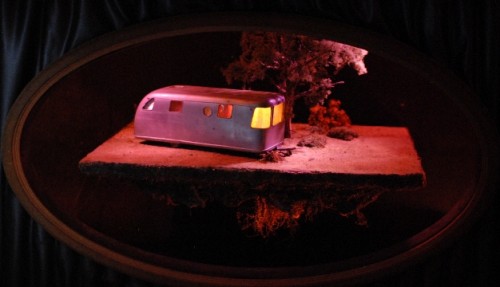
Garden of Eden on Wheels, exhibition at the Museum of Jurassic Technology. Via Flickr.com/photos/saschapohflepp/.
While this evolution suggests an unbridgeable divide between wonder and knowledge, numerous contemporary artists are making work that reunites these apparent polarities. Such artists create metaphorical Wunderkammern in the guise of curiosity cabinets. They use scientific motifs to reveal the limitations of science and reason, introducing puzzlement into normally pedantic viewing experiences.
At the Museum of Jurassic Technology in Los Angeles, proprietor David Wilson employs the institutional language and conventions of natural history museums to display dubious artifacts like Ricky Jay’s collection of decaying dice and a collection of Los Angeles mobile home models. His collection, which teeters on a line between fantasy and truth, introduces doubt into the veneer of scientific authority; these cracks become spaces of cultivation where speculation and wonder have room to grow.

Trevor Paglen, "KEYHOLE/ADVANCED IKON (USA 161) in Milky Way," C-print, 2007. Courtesy the artist and Bellwether Gallery, New York.
Photographer and experimental geographer Trevor Paglen draws on photography’s scientific legacy and believed ability to reveal and quantify, creating photographs that obscure and thwart our desire for knowledge. In doing so, he pokes holes in the medium’s supposed omniscience. KEYHOLE/ADVANCED IKON (USA 161) in Milky Way (2007) has such an impressive title, but its promise fades when you realize how little we learn from it. In the absence of orienting data, the viewer returns to the image of the night sky: its mystery intact, we become lost in our galaxy’s pinholes of light instead.
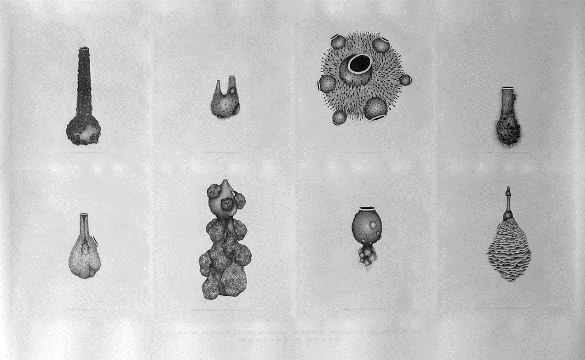
Amber Stucke, "Various Species of Behavioral Vessels: Parasitic Relationships (Symbiosis State)," 2010.Graphite, gouache, and ink on paper, 50 x 82 inches.
Amber Stucke, who recently received her MFA from the California College of the Arts, creates taxonomies of fictional fungi whose detailed contours take precedence over their organizing structures. The bulbous organisms sprout kelp-like leaves and shelves of wavy mushrooms; they are covered by blankets of lichen and algae. Drawing on the visual language of scientific taxonomies, Stucke defies these systems’ potential reductionism through the physical attention she devotes to each specimen. Every nodule and undulation, every tumor and sprout is so meticulously rendered by the artist’s hand that the individual, imaginary organisms overshadow any intimations of uniformity.
These three artists use technical language and visual styles to subvert their chosen systems and reveal their subjects’ inherent poetry. While wonder and knowledge may not be wholly reconciled in these examples, they are, at the very least, on speaking terms.
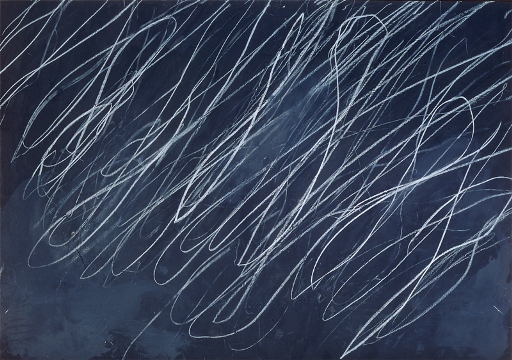
Cy Twombly, "Untitled," 1970. Distemper and chalk on canvas. Photo via Wikimedia Commons.
“Grammar is both a science and an art,” writes Bryan A. Garner in the Chicago Manual of Style, 15th Edition, the copy editor’s book of faith. The science lies in naming the parts of speech and recording the many ways words can come together to create meaning. The art, however, comes in allowing room for words to go outside the lines we draw around them. e.e. cummings, that famous grammatical rule-breaker, argued for emotion over order, writing: “since feeling is first/ who pays any attention/ to the syntax of things … for life’s not a paragraph.” There is much to be learned from the sentence that breaks the rules, the one whose syntax we can’t parse and punctuation we can’t decipher, whose meaning is imminent rather than staring us in the face.





Pingback: Bedfellows | Both a Science and an Art | All about painting
Pingback: Box Set Match | Michael J. Kramer